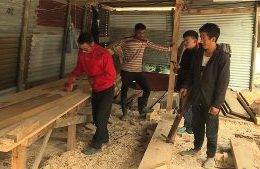Bhutan’s revered spiritual heritage is under growing threat as cases of vandalism targeting sacred sites continue to rise across the country. Between 2012 and 2024, a staggering 1,360 religious monuments—including 1,291 choetens (stupas) and 69 lhakhangs (temples)—have been desecrated, according to data from the Ministry of Home Affairs.
In 2024 alone, authorities recorded 51 incidents of vandalism, with choetens once again bearing the brunt, accounting for 43 of those cases. Although slightly fewer than the 54 incidents reported in 2023, the figures remain alarming. As of March this year, four more cases have been reported in Haa, Trashigang, Lhuentse, and Trashiyangtse.
The issue was brought to the forefront in the National Assembly yesterday by Sergithang-Tsirangtoed MP Lhakpa Tshering Tamang, who urged the government to take decisive action. Calling for a nationwide inventory of nangtens—the sacred relics housed in these sites—he appealed for a concrete plan to protect Bhutan’s spiritual and cultural legacy from vandalism and fire.
“As a deeply Buddhist nation, we are the custodians of spiritual treasures blessed by our forefathers. We have a profound moral and cultural responsibility to preserve these sacred items for future generations,” said MP Lhakpa Tshering Tamang during the Assembly session.
In response, Home Minister Tshering outlined several initiatives underway through the Department of Culture and Dzongkha Development (DCDD). He noted that the department has been working systematically to document all choetens and lhakhangs built before 1960, categorising them into three levels of protection: topmost priority, nationally important, and locally important.
Currently, Bhutan has 4,471 choetens and 2,471 lhakhangs dating back to before 1960. Of these, 1,590 choetens and 265 lhakhangs fall into the topmost priority category. Trashigang leads with the highest number of priority choetens (471), while Bumthang tops the list for lhakhangs (44).
To bolster protection, the DCDD is keeping detailed records of newly built sites and their relics. Measures such as proper handover procedures when caretakers resign, the installation of CCTV cameras, and public awareness campaigns have been introduced.
Addressing the rising fire threats to these monuments, the department has also equipped key sites with fire extinguishers, water reservoirs, and smoke and heat detectors. Dzongkhags have been instructed to build separate butter lamp houses outside temples, upgrade aging electrical systems, and create firebreaks around heritage sites. Police officers and monks are also receiving emergency fire response training.
Experts believe the causes of vandalism are multifaceted. Economic hardship and unemployment, the isolated locations of many heritage sites, the lure of the black market for religious artifacts, and gaps in monitoring and infrastructure all contribute to the problem.
Community involvement, however, is increasingly seen as a crucial piece of the solution. Locals are being encouraged to take greater responsibility in safeguarding nearby monuments and to report suspicious activities promptly. Enhanced surveillance, public education, economic reforms, and tighter security around sacred relics are also seen as essential to preserving Bhutan’s spiritual foundations.
As the nation confronts these challenges, the preservation of its sacred sites is not just about protecting physical structures, but about safeguarding the spiritual heart of Bhutan itself.








